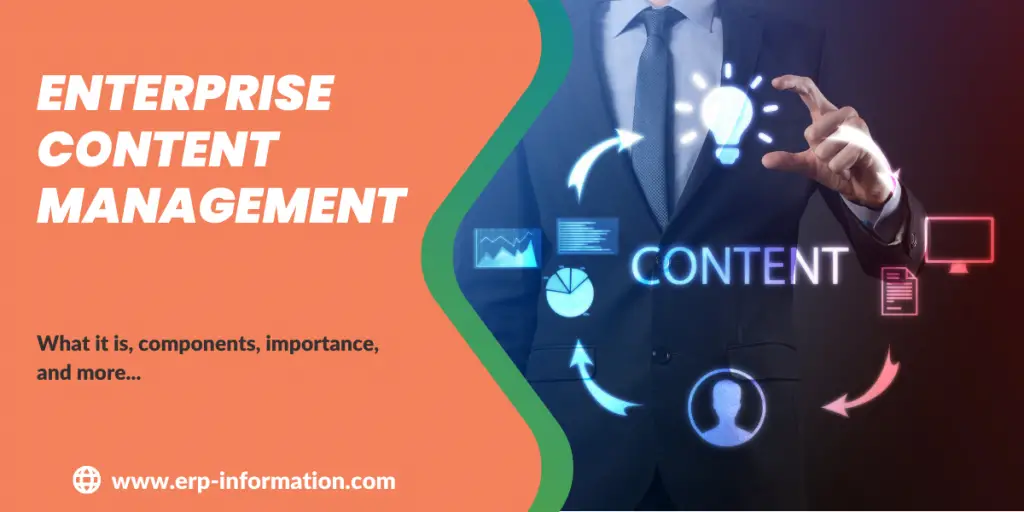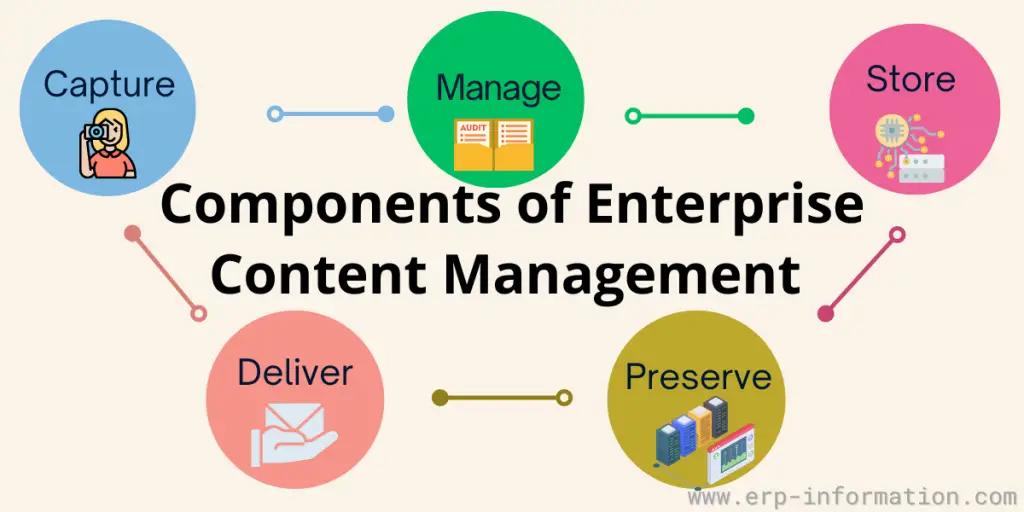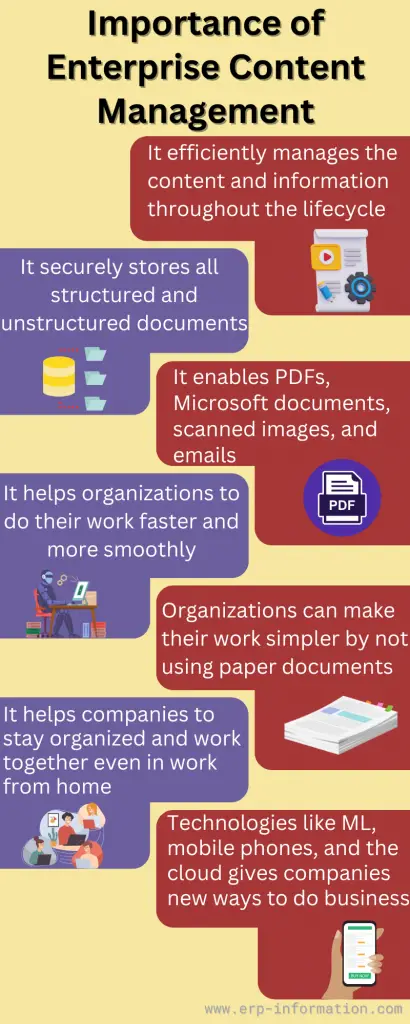Many of you struggle to keep your business organized. Do you ever feel overwhelmed by multiple versions of the same document or have difficulty finding relevant content when you need it? Enterprise content management (ECM) can help.
ECM is a powerful tool that enables businesses to have better control over their digital assets by creating an organized and secure repository for documents, images, videos, and other forms of data.
In this blog post, we will look at how enterprise content management technology works and what it can do for your organization, its importance, components, challenges, and implementation tips, so let’s get started!
What is Enterprise Content Management?
It is a solution for businesses to get, organize, save, and share important information with employees, partners, and customers. It also helps track when the information was created or updated and how it should be shared.
ECM system stores items, either in digital or analog form, in a safe place. It also provides ways to bring new items into the system and show them so people can use them.
ECM in 2016 was based on the Document Management Systems (DMS) from the late 1980s and early 1990s.
These systems could store images, manage documents, send documents to different people for approval, and help create relationships between businesses. Later ECM adopted new technologies, and many organizations started to use it.
Technology has changed, and now content means more than just words. Content includes videos, sounds, posts on social media, emails, websites, and more.
ECM can manage all these different types of content. In addition, it can handle structured and unstructured content.
- Structured content: Structured content is organized and clearly defined information, like databases or code.
- Unstructured content: It has no specific format and can include office documents, PDFs, and emails.
Many enterprise content management software is available to help you out in content management progress.
What is Enterprise Video Content Management?
Enterprise video content management helps organizations manage their videos and other digital information. It lets people capture, process, store, find, and share the media in a secure place. This is for both internal and external use.
Enterprise video content management may also include associated network services like Video Content Delivery Networks, which help to deliver videos to collaborative spaces.
Enterprise video management helps companies show videos to co-workers and customers. It also helps employees share videos within the company.
In addition, enterprise firms use it for video conferencing, training, and events. That is why enterprise video management has grown a lot in popularity.
Components of ECM
ECM is of five major components. AIIM (Association for Intelligent Information Management) defines each content’s purpose. Here we are providing a brief explanation of the five components.
Capture
The capture component involves changing paper documents into digital formats. It also means getting electronic files and arranging them in a way that makes sense. Information includes things like invoices, contracts, and research reports.
There are a few methods for capturing. They are, using electronic forms, scanning paper documents, automatically filing and categorizing the documents, and securing the nativity of digital content(PDF, Microsoft docs, video files).
Managing the documents
The management component helps connect, change, and use information. This includes organizing documents, working together on a computer, managing what is on the internet, and keeping records.
Managing the documents in the following areas
- Document management system(DMS)
- Collaborative software
- Web content management
- Records management
- Workflow and business process management (BPM)
Store documents
The store component saves information in its memory for a short time. This lets users view or change the info quickly and easily.
You can choose who can look at, change, and make documents. You can also label and search for documents using words that describe the document. Finally, you can organize your documents into different folders.
Store components are also categorized into the following categories
- Repositories
- Library services
- Storage technologies
Preserve
Preserve is a way to keep important information safe and secure for a long time. It also helps companies follow the rules set by the government or industry. Preserve is usually done with ECM records management.
Electronic archiving is used to keep information around for a long time. This means moving applications, index data, metadata, and objects from older systems to newer ones.
Deliver
Deliver components can add information to other systems. For example, they can transfer info to a different storage or make output files.
Deliver components are divided into transformation, security, and distribution. Transformation and security help all the ECM parts work together. For output, there are tools to design the presentation of the info and then distribute it.
Importance of ECM
- ECM can efficiently manage the content and information throughout the lifecycle.
- It enables PDFs, Microsoft documents, scanned images, and Emails that are unstructured.
- It securely stores all structured and unstructured documents.
- It helps organizations to do their work faster and more smoothly.
- Organizations can make their work simpler and more efficient by not using paper documents and organizing information best for their business.
- Companies need ECM to help them stay organized and work together even in work from home.
- Technology like machine learning, mobile phones, and the cloud gives companies new ways to do business.
Benefits
Minimizes the business risk
It is a platform that stores and shares content. It follows rules and guidelines to make sure everything is safe. It eliminates processes that could cause problems or put the business at risk of breaking the law.
Secure place to store content
ECM software helps businesses store information in one secure place. As a result, everyone only uses the same approved and accurate information. This reduces the risk of mistakes or wrong versions of information being used.
Cost reduction
It automates tasks that used to have to be done by hand. It also lowers the costs of penalties for not following the rules, storage space, and postage.
Business continuity
It can help a business keep its content available and running. It helps with backups, setting up archives, and recovering if something bad happens.
More productivity, less paperwork
It can make accessing files and doing business easier. It can also help save space, reduce paper and mail needs, keep information secure, and not take too long. All of these things can help people be more productive.
Better customer experience and content accessibility
Customer service representatives can access the right information when helping customers. It makes it easier and faster for employees to help customers, which makes them happier. Users can use search ranges and parameters to help them find information faster.
Where Does ECM is Used in Organizations?
It is used in the following areas.
| Areas | Uses |
| Account payables | Collects invoice information and automates the POs and invoice matching. |
| Services | Provides access to clients and customers of important documents online anytime. |
| Recruitment | It makes bringing new staff to your company easier with all the paperwork and decision-making done quickly. |
| Securing the information | It uses special tools to help keep information secure and follow all the rules. |
| Work from home | It provides content accessible to those who work remotely. |
Implementation Tips
The following are tips that may help you in the implementation process.
Audit the content
The first step to making a plan for managing content is to list all the types of content your organization works with. What business processes are these used in, and who is responsible for these contents?
Define the organization’s goals
Streamlining the business, reducing the dependency on paper, reducing the organizational risks, providing efficient service to customers, etc. And proper planning will help you to reach the goal.
Review the progress
Businesses should use Agile or Scrum methodology when implementing Enterprise Content Management. This way, stakeholders can review the progress every two weeks or every month.
Update continuously
Enterprise Content Management is not something you do once and forget about. It’s important to keep updating it to get the most value to your business.
Challenges of ECM
- This has to face large security issues. For example, websites that use CMSs are more likely to be hacked than websites without one or those that are coded by hand.
- Maintenance of content is expensive.
- Need to learn about the CMS (Content Management System) before working on it.
- You need to consider Search Engine Optimization.
- Regular updation of content is required. Otherwise, you may lose visitors to your website.
FAQs
What are the objectives of ECM?
The objective is to help people find the content they need quickly and easily. It searches contents through different places to find the information you need and help you act on it.
What is an enterprise content management strategy?
The enterprise content management strategy stores the documents, centralizes, shares them, and provides security.
Conclusion
In conclusion, enterprise content management brings great advantages to organizations. It helps them streamline processes, save time and money, make them compliant, and increase productivity.
The benefits make ECM a worthy investment to gain competitive advantage and scale operations.
Although it is a complex technology to implement, organizations can get help from cloud solution providers for easier deployment that will positively impact their organization’s operational efficiency and workflow.


